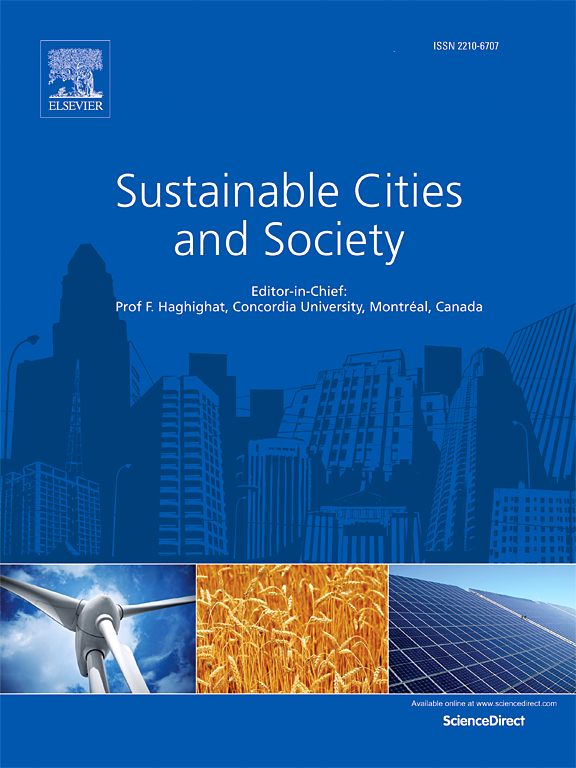IF 10.5
1区 工程技术
Q1 CONSTRUCTION & BUILDING TECHNOLOGY
引用次数: 0
摘要
间接绿色外墙(IGF)的空腔微环境会影响建筑物的热性能。然而,精确模拟这种环境仍然是一项挑战。为了解决这个问题,我们采用 OpenFOAM 进行计算流体动力学模拟,将植被作为多孔介质建模。叶片能量平衡模型用于求解叶片温度和热通量。我们研究了叶面积密度(LAD)、空腔厚度和太阳辐射方向对 IGF 热性能的影响。我们还探讨了 IGF 在中国上海夏季的日热效应。结果表明:(1)位于迎风面(0.07 米/秒)和背风面(0.14 米/秒)的中空玻璃以最高的 LAD 和最大的空腔厚度实现了最高的风速降低。(2) LAD 高、空腔厚度小的 IGF 能有效冷却墙面。当背风面接受大部分太阳辐射时,墙面降温幅度最大(16.93°C)。(3) 在中国上海,安装在西侧的 IGF 制冷效果显著,空腔内和墙面的最高温度分别降低了 3.21°C 和 16.41°C。这项研究为中空玻璃隔热箱开发了一个新的模拟框架,并为优化中空玻璃隔热箱的设计提供了启示。本文章由计算机程序翻译,如有差异,请以英文原文为准。
Parametric analysis of planting strategies and environmental factors for the thermal and aerodynamic effects of indirect green façades
The cavity microenvironment of indirect green façades (IGFs) influences building thermal performance. However, precisely simulating this environment remains a challenge. To address this, we employed OpenFOAM for computational fluid dynamics simulations, vegetation was modeled as a porous medium. A leaf energy balance model was used to solve leaf temperature and heat fluxes. We investigated the effect of leaf area density (LAD), cavity thickness, and solar radiation direction on the thermal performance of IGFs. The daily thermal effects of IGFs during summer in Shanghai, China were also explored. The results showed that (1) The IGFs on the windward side (0.07 m/s) and leeward side (0.14 m/s) achieved the highest wind speed reductions with the highest LAD and largest cavity thickness. (2) An IGF with high LAD and small cavity thickness effectively cooled the wall surface. The maximum wall surface cooling (16.93°C) was observed when the leeward side received the majority of solar radiation. (3) IGFs installed on the west side demonstrated significant cooling, with maximum temperature reductions of 3.21°C and 16.41°C within the cavity and on wall surfaces, respectively, in Shanghai, China. This research developed a new simulation framework for IGFs and provided insights for optimizing IGF design.
求助全文
通过发布文献求助,成功后即可免费获取论文全文。
去求助
来源期刊

Sustainable Cities and Society
Social Sciences-Geography, Planning and Development
CiteScore
22.00
自引率
13.70%
发文量
810
审稿时长
27 days
期刊介绍:
Sustainable Cities and Society (SCS) is an international journal that focuses on fundamental and applied research to promote environmentally sustainable and socially resilient cities. The journal welcomes cross-cutting, multi-disciplinary research in various areas, including:
1. Smart cities and resilient environments;
2. Alternative/clean energy sources, energy distribution, distributed energy generation, and energy demand reduction/management;
3. Monitoring and improving air quality in built environment and cities (e.g., healthy built environment and air quality management);
4. Energy efficient, low/zero carbon, and green buildings/communities;
5. Climate change mitigation and adaptation in urban environments;
6. Green infrastructure and BMPs;
7. Environmental Footprint accounting and management;
8. Urban agriculture and forestry;
9. ICT, smart grid and intelligent infrastructure;
10. Urban design/planning, regulations, legislation, certification, economics, and policy;
11. Social aspects, impacts and resiliency of cities;
12. Behavior monitoring, analysis and change within urban communities;
13. Health monitoring and improvement;
14. Nexus issues related to sustainable cities and societies;
15. Smart city governance;
16. Decision Support Systems for trade-off and uncertainty analysis for improved management of cities and society;
17. Big data, machine learning, and artificial intelligence applications and case studies;
18. Critical infrastructure protection, including security, privacy, forensics, and reliability issues of cyber-physical systems.
19. Water footprint reduction and urban water distribution, harvesting, treatment, reuse and management;
20. Waste reduction and recycling;
21. Wastewater collection, treatment and recycling;
22. Smart, clean and healthy transportation systems and infrastructure;
 求助内容:
求助内容: 应助结果提醒方式:
应助结果提醒方式:


